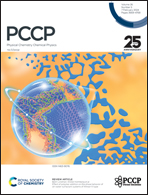A structural study on a specific Li-ion ordered complex in dimethyl carbonate-based dual-cation electrolytes†
Abstract
Dimethyl carbonate (DMC) is a linear carbonate solvent commonly used as an electrolyte for electric double-layer capacitors (EDLCs) and Li-ion batteries. However, there are serious problems with the use of DMC as an electrolyte solvent: (1) low ionic conductivity when using Li salts (e.g. LiBF4) and (2) liquid–liquid phase separation when using spiro-type quaternary ammonium salts (e.g. SBPBF4). Dual-cation electrolytes, i.e., bi-salt (SBPBF4 and LiBF4) in DMC, are promising candidates to avoid the phase separation issue and to enhance the total and Li+ conductivities. Herein, we reported a specific Li-ion structure in DMC-based dual-cation electrolytes by combining high-energy X-ray total scattering (HEXTS) and all-atom molecular dynamics (MD) simulations. Quantitative radial distribution function analysis based on experimental and simulation results revealed that the phase-separated SBPBF4/DMC (i.e., the bottom phase of 1 M SBPBF4/DMC) forms long-range ion ordering based on the structured SBP+–BF4− ion pairs. When adding LiBF4 salt into SBPBF4/DMC (i.e., dual-cation electrolyte), the ordered SBP+–BF4− structure disappeared owing to the formation of Li-ion solvation complexes. We found that in the dual-cation electrolyte Li ions form multiple Li+–Li+ ordered complexes in spite of relatively low Li-salt concentration (1 M), being a promising Li+-conducting medium with reduced Li salt usage and low viscosity.

- This article is part of the themed collection: 2024 PCCP HOT Articles


 Please wait while we load your content...
Please wait while we load your content...